the Same Old Christmas Story Over Again
Who Is Father Christmas?
by Dawn Copeman
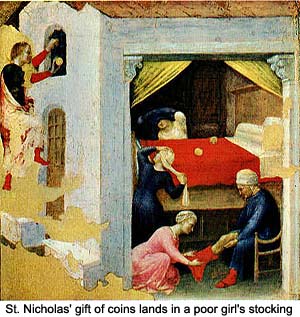 Many people today recollect that Father Christmas is only the British name for Santa Claus. Whilst it is true that Father Christmas and Santa are considered about the same today, Father Christmas is a completely dissimilar person entirely, with a much longer history.
Many people today recollect that Father Christmas is only the British name for Santa Claus. Whilst it is true that Father Christmas and Santa are considered about the same today, Father Christmas is a completely dissimilar person entirely, with a much longer history.
The American Santa Claus has one source. He originated from Dutch settlers' stories near Sinter Klass, the Dutch name for St Nicholas, and how he gave presents to girls and boys.
St Nicholas was Bishop of Myra, in Turkey in the 3rd century AD, who would travel in his red bishop's robes and give gifts to the poor. He was believed to have been particularly kind to children. Apparently, he was besides very shy. Legend has it that one twenty-four hour period, wanting to requite money to a family unit in hole-and-corner, he dropped some gold coins down the chimney, where they landed in a girl's stocking. St. Nicholas didn't 'go far' in United kingdom until after the Norman invasion, and when he did get in his story was quickly absorbed into the legend of Father Christmas. By this time, our Father Christmas had already been around for centuries!
The earliest Father Christmas appeared during ancient British mid-winter festivals. He wasn't known as Father Christmas so, of course, just as a general infidel figure who represented the coming of bound. He would wear a long, green hooded cloak and a wreath of holly, ivy or mistletoe. It is the association with holly and mistletoe, and his power to lift people's spirits, that we retain from this ancient Father Christmas.
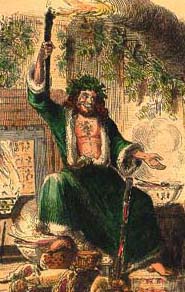 When Great britain vicious under Saxon rule in the fifth and sixth centuries Advertising, Begetter Christmas took on the characteristics of the Saxon Father Fourth dimension, also known as King Frost or Male monarch Winter. Someone would apparel upward as Male monarch Wintertime and be welcomed into homes, where he would sit well-nigh the burn down and be given something to eat and drink -- a flake like our mince pies and whisky for Father Christmas, perhaps? It was thought that by being kind to Rex Winter, the people would get something good in return: a milder wintertime. Thus Father Christmas became associated with receiving good things.
When Great britain vicious under Saxon rule in the fifth and sixth centuries Advertising, Begetter Christmas took on the characteristics of the Saxon Father Fourth dimension, also known as King Frost or Male monarch Winter. Someone would apparel upward as Male monarch Wintertime and be welcomed into homes, where he would sit well-nigh the burn down and be given something to eat and drink -- a flake like our mince pies and whisky for Father Christmas, perhaps? It was thought that by being kind to Rex Winter, the people would get something good in return: a milder wintertime. Thus Father Christmas became associated with receiving good things.
This association was strengthened when the Vikings invaded U.k. and brought their own midwinter traditions with them. The 20th through the 31st of December is known every bit Jultid -- the time when the Norse God Odin takes on the character of Jul, one of his twelve characters, and visits the globe. The proper name lives on today as Yuletide. During Jultid Odin, a portly, elderly human with a white beard and a long, blueish, hooded cloak was said to have ridden through the world on his eight-legged horse Sleipnir, giving gifts to the practiced and punishments to the bad. Our Father Christmas became fat like Odin and developed the ability to automatically know whether people had been bad or practiced. Also like Odin, Father Christmas could travel magically and be in lots of places in a curt space of fourth dimension.
Then with the inflow of the Normans and the story of St Nicholas the creation of the British Father Christmas was complete. Our offset written reference to the entity of Male parent Christmas is establish in a 15th century carol, which includes the line "Welcome, my lord Christëmas." From this point onwards, Father Christmas is seen to represent the spirit of Christmas: that of good cheer and benevolence to all. In Tudor and Stuart times Sir Christmas or Helm Christmas was called upon to preside over the Christmas entertainment in big houses. In 1638, we got our first image of Father Christmas courtesy of Thomas Nabbes, who illustrated him as an one-time human in a furred glaze and cap.
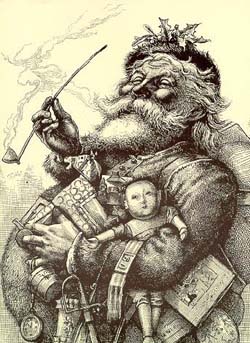 But this reverence of a infidel figure and revelry was too much for the Puritans, and so in 1644 they banned Christmas and Male parent Christmas as well. Father Christmas and so went underground and took a greater part in Mummers Plays, often striding onto the stage at the get-go of the play to say "In comes I, old Father Christmas, be I welcome or exist I not? I promise old Father Christmas, will never be forgot." He besides appeared in hugger-mugger newspapers nether the name of Sometime Christmas, where he was used every bit a representation of what people felt nigh Christmas and what they missed about it.
But this reverence of a infidel figure and revelry was too much for the Puritans, and so in 1644 they banned Christmas and Male parent Christmas as well. Father Christmas and so went underground and took a greater part in Mummers Plays, often striding onto the stage at the get-go of the play to say "In comes I, old Father Christmas, be I welcome or exist I not? I promise old Father Christmas, will never be forgot." He besides appeared in hugger-mugger newspapers nether the name of Sometime Christmas, where he was used every bit a representation of what people felt nigh Christmas and what they missed about it.
Nonetheless it was not until the Victorian age that Male parent Christmas was truly revived as the spirit of Christmas. The Victorian Father Christmas embodied elements of all his predecessors and was usually drawn equally a jolly, pagan figure in a long, hooded coat -- the colour of which could be red, blue, green or brown. The Ghost of Christmas Nowadays in A Christmas Carol as illustrated by John Leech, is very infidel indeed; with his dark-green cloak and holly wreath he is a direct link to the virtually aboriginal Christmas Spirit of all.
By the eye of the 20th century, our Father Christmas had changed over again. This time he was heavily influenced by America -- by Clement C. Moore'due south 1822 poem "The Night before Christmas", by the illustrations it inspired Thomas Nash to draw for Harper's Weekly, and by the Coca Cola Visitor.
In Moore'south poem we meet a St Nick who combines all the characteristics of Odin, St Nicholas and our Father Christmas. From Nash's drawings, which were heavily influenced by Moore's verse form, nosotros got the thought that Santa lives at the North Pole, has a list of practiced and bad children and reads letters from children -- messages which in Britain were posted up the chimney! And although Begetter Christmas had worn cherry-red earlier, to stand for St Nicolas' Bishop'due south Robes, information technology was the Coca Cola Company's advertizing of 1931 that helped to make reddish the standard colour for Father Christmas's coat.
Thus Santa and Father Christmas became one. Merely although they are similar today, Father Christmas is not Santa; he is much, much more than that.
| | |
In this medley of Victorian cards, the robes of Santa or Begetter Christmas range from blue and turquoise to royal and light-green, sometimes trimmed with fur or flecked with stars. In nigh cases, Santa has non developed the "bowl full of jelly" abdomen that Clement Moore ascribed to him.
| In Harper's Weekly in 1863, Santa Claus (whose robe seems to exist covered with stars) gives gifts to Union troops. | By 1874 in Harper's Weekly, Santa'south costume seems to becoming closer to what nosotros're familiar with today. |
Dawn Copeman is a freelance writer and commercial writer who has had more than 100 articles published on travel, history, cookery, health and writing. She currently lives in Lincolnshire, where she is working on her first fiction volume. She started her career as a freelance writer in 2004 and has been a contributing editor for several publications, including TimeTravel-Britain.com and Writing-World.com .
mccrayworterincur.blogspot.com
Source: https://www.timetravel-britain.com/articles/christmas/santa.shtml
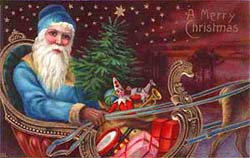
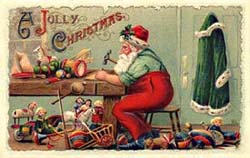
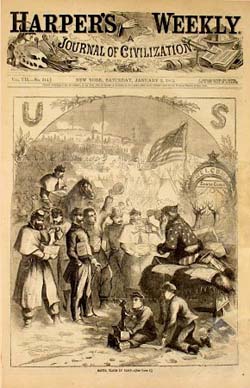
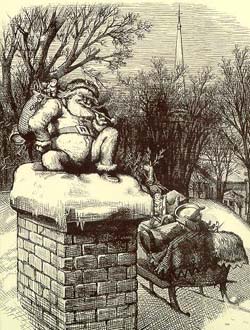
0 Response to "the Same Old Christmas Story Over Again"
Post a Comment